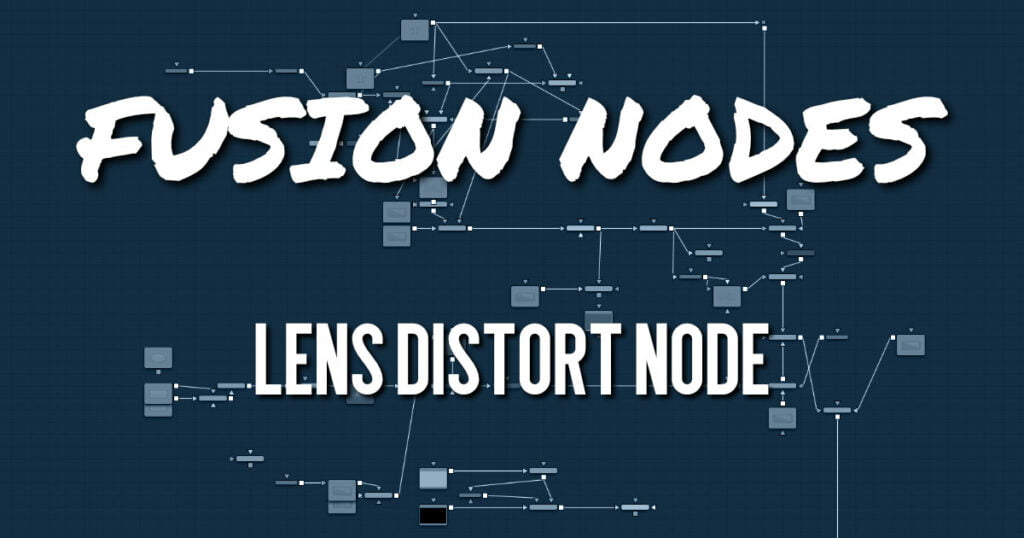
This node can be used to remove or add lens distortion in an image. The lens distortion in an image depends on the lens, quality, number of elements, and many other factors.
One reason to remove lens distortion is to composite with an undistorted layer. For example, compositing a 3D element over a distorted live-action layer will cause unwanted effects like straight lines not matching up on the foreground and background. The resulting composite will not look believable.
Lens Distort Node Inputs
The two inputs on the Lens Distort node are used to connect a 2D image and an effect mask, which can be used to limit the distorted area.
- Input: The orange input is used for the primary 2D image that is distorted.
- Effect Mask: The blue input is for a mask shape created by polylines, basic primitive shapes, paint strokes, or bitmaps from other tools. Connecting a mask to this input limits the distortion to only those pixels within the mask. An effects mask is applied to the tool after the tool is processed.
Lens Distort Node Setup
A simplified example below applies the Lens Distort in Undistort mode to the MediaIn1 live-action layer, composites the 3D elements, and finally applies the Lens Distort at the end with the same settings, but this time in Distort mode to get the original look and distortion back into the image.
Lens Distort Node Controls Tab
The Controls tab presents various ways to customize or build the lens distortion model you want. Camera Settings allow you to specify the camera used to capture the content.
Mode
Undistort removes the lens distortion to create a flattened image. Distort brings the original lens distortion back into the image.
Edges
Determines how samples that fall outside the frame are treated.
- Canvas: Pixels outside the frame are set to the default canvas color. In most cases, this is black with no alpha.
- Duplicate: Pixels outside the frame are duplicated. This results in “smeared” edges but is useful when, for example, applying a blur because in that case black pixels would result in the unwanted blurring between the actual image and the black canvas.
Clipping Mode
- Domain: Retains all pixels that might be moved out of the frame for later re-distorting.
- Frame: Pixels moved outside the frame are discarded.
Output Distortion Map
Outputs the location of pixels as a warped screen-coordinate map.
Camera Settings
The options known from the Camera 3D are duplicated here. They can either be set manually or connected to an already existing Camera 3D.
Lens Distortion Model
Select the appropriate 3D Equalizer Lens Distortion model here: 3DE Classic Model, 3DE4 Anamorphic, 3DE4 Radial Fisheye, or 3DE4 Radial. Please consult the 3D Equalizer manual for further explanation. The sliders in the 3DE Classic LD Model are most likely best suited for manually applying (un)distortion, without having imported lens data.
Supersampling [HiQ]
Sets the number of samples used to determine each destination pixel. As always, higher supersampling leads to higher render times. 1×1 bilinear is usually of sufficient quality, but with high lens distortion near the edges of the lens, there are noticeable differences to higher settings.
Supersampling Mode [HiQ]
The type of sample done for each supersample. Nearest leads to a crisper but more aliased image. BiLinear gives a blurrier result.
Load Distortion Data
Allows the user to load a Lens Distortion profile created, for example, by the 3D Equalizer.
How to Manually Determine Lens Distortion
In an ideal world, one would have exact lens parameters from each lens that was used during the shoot, and one could use those values to undistort the image. However, in the real world, those parameters have not been taken on set or don’t match. Another approach is to use software like 3D Equalizer, which analyzes the footage and delivers a dataset that can be imported into the Lens Distort node right away.
And finally, one could try to manually eyeball the amount of lens distortion using the control sliders. To do that, one could either look for horizontal or vertical lines in the footage that are supposed to be straight and straighten them out using the controls, or shoot a full-frame checkerboard pattern on set as a reference.
Lens Distort Node Settings Tab
The Settings tab in the Inspector is also duplicated in other Warp nodes. These common controls are described in detail HERE.










